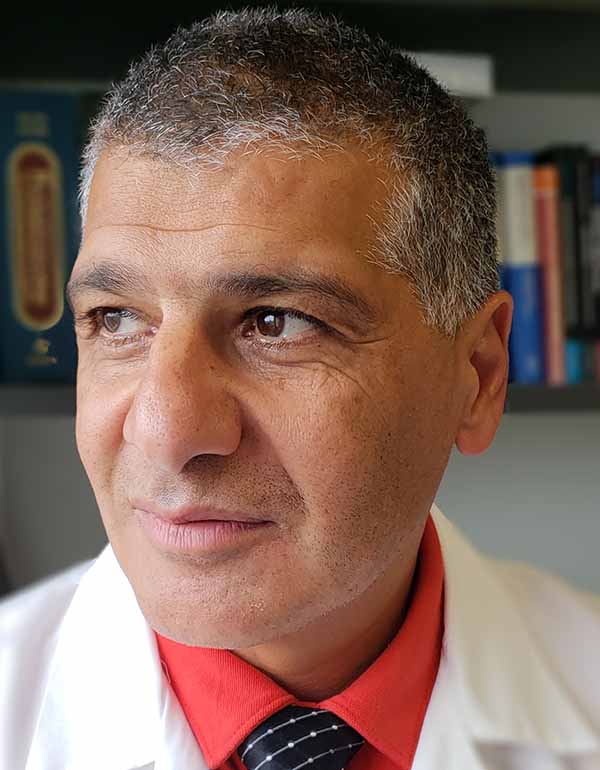Project 1: Electronic Health Record Phenotyping and Genomics of Opioid Addiction
Project Overview
In Project 1 we are undertaking an ambitious effort to perform the largest genome wide association study of opioid addiction, to date. With over 100,000 genomes represented and a focus on clinically relevant “real-world” addiction phenotypes extracted from electronic health records, we will be well positioned to identify individual genetic variants that increase likelihood of addiction. We will be working closely with the Synergy Core to develop models of opioid addiction that maximize biologically meaningful discovery. Lastly, we will conduct additional bioinformatic analyses of the variants, genes, and pathways that are identified in the GWAS.
Project Goals
- To derive EHR-based phenotypes for opioid addiction.
- To identify genetic variants that increase the likelihood of addiction.
- To gain biological insight into the genes and pathways implicated in the GWAS.
Key Staff



Project 2: Gene Regulation in Opioid Dependent Human Brain
Project Overview
The work proposed in Project 2 combines multi-omics resources to examine specific hypotheses regarding the functional brain architecture of Opioid Use Disorder (OUD). Guided by existing theory implicating the prefrontal cortex, nucleus accumbens, and amygdala in the cycle of substance abuse, we propose to generate and combine existing data at multiple Omics levels in each brain region using post-mortem human tissue collected from opioid overdose cases and matched controls. The measurement approaches we use are genome-wide, in each of the 3 brain regions and in each biological domain: SNP, epigenome (DNA methylation and histone acetylation) and transcript (via RNA-Seq) in our combined sample, with planned replication in outside samples.
Project Goals
- Integrated existing combined cohort data containing gene expression, DNAme and histone acetylation
- Generate histone acetylation and RNA-seq data for Amygdala samples
- Integrate Amygdala data with existing histone acetylation, DNAme and RNA-seq from PFC and NAc
- Perform genome-wide association mapping, including histone modification- (hm), DNA methylation- (DNAm) and gene expression- (e) QTL mapping, to identify genetic variants that account for the regulatory differences observed between cases and controls.
Key Staff



Project 3
Project Overview
The goal of Project 3 (Multi-species Approach to Opioid Addiction) is to integrate human and non-human genetic and genomic datasets to identify key molecular pathways relevant o opioid addiction (OA). Integration of human and non-human data has been highlighted in numerous recent meetings as one of the most significant and enduring challenges in the field of addiction genetics. This project will use human data in Projects 1 and 2 as well as other available human datasets in conjunction with data from mice and rats.
Project Goals
- Methods will be developed to integrate data by summarizing data at the level of genes, thus taking advantage of genes ortholog as the primary means for cross-species integration
- Dr. Chesler will continue to develop and use GeneWeaver to identify candidate genes and pathways
- Dr. Palmer will adapt NetColoc and Polygenic Transcriptomic Risk Scores for use with heterogeneous rat GWAS of oxycodone and heroin self-administration
Key Staff


Dr. Abraham Palmer earned his undergraduate degree in Biology at the University of Chicago (1992). He then earned a Ph.D. in Biomedical Science at the University of California San Diego (1999), where he studied the interaction of genes and behavior in rats. Dr. Palmer then did a postdoctoral fellowship in behavioral genetics at Oregon Health Sciences University, followed by a second postdoctoral fellowship in genetics and genomics at Columbia University, where he was subsequently promoted to Research Scientist (2004). In 2005 Dr. Palmer returned to the University of Chicago as an Assistant Professor of Human Genetics with a joint appointment in Psychiatry. He was promoted to Associate Professor in 2012 and to Full Professor in 2015. In 2016, Dr. Palmer moved to UCSD where is now Professor and Vice Chair for Basic Science in the Department of Psychiatry.
Dr. Palmer's research uses humans, rats, mice and zebrafish to discover genes that influence variability in behavioral phenotypes (www.palmerlab.org). His use of animal models is intended to elucidate the mechanisms by which specific genes influence behavior at the molecular, cellular and neuroanatomical levels. Dr. Palmer has published over 221 papers and book chapters. He has received grants from the National Institutes for Drug Abuse (NIDA), Mental Health (NIMH), Alcohol Abuse and Alcoholism (NIAAA), General Medical Sciences (NIGMS), the National Science Foundation (NSF) the Tobacco-Related Disease Research Program (TRDRP) and from private foundations including the Schweppe Foundation and the Brain & Behavior Research Foundation. He is currently the PI of a NIDA-funded P50 National Center of Excellence (www.ratgenes.org) as well as several R01s and U01 grants. He is a fellow of the American Association for the Advancement of Science (AAAS) and has received various awards and recognitions, including the 2020 IBANGS Senior Investigator Award and the 2022 UC San Diego Health Sciences Faculty Excellence in Mentoring Award.
Synergy Core

Project Overview
The Synergy Core (SC) supports the overall mission of IOmics-OA by coordinating a unified and rigorous approach to data analysis across the center. The SC facilitates integration across IOmics-OA projects and with OA-related efforts in the larger research community to effect scientific synergy. Research output from IOmics-OA will be distributed by the SC via mapOA, a web-based data portal providing easy exploration and acquisition of robustly QC'ed and harmonized results from all projects and ingested publicly available data. The efforts of the SC will ensure that the research community receives maximum benefit from the center.
Project Goals
- Align IOmics-OA analyses with milestones set by the Center Steering Committee and coordinate development of analytic techniques, pipelines, standards, procedures, and documentation
- Ingest, standardize, and analyze external OA datasets and conduct integrative analyses across IOmics-OA and external data
- Develop mapOA, a user-friendly web-based resource for sharing of integrated OA omics within ICAN and with the broader research community



